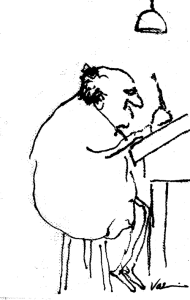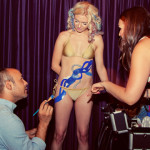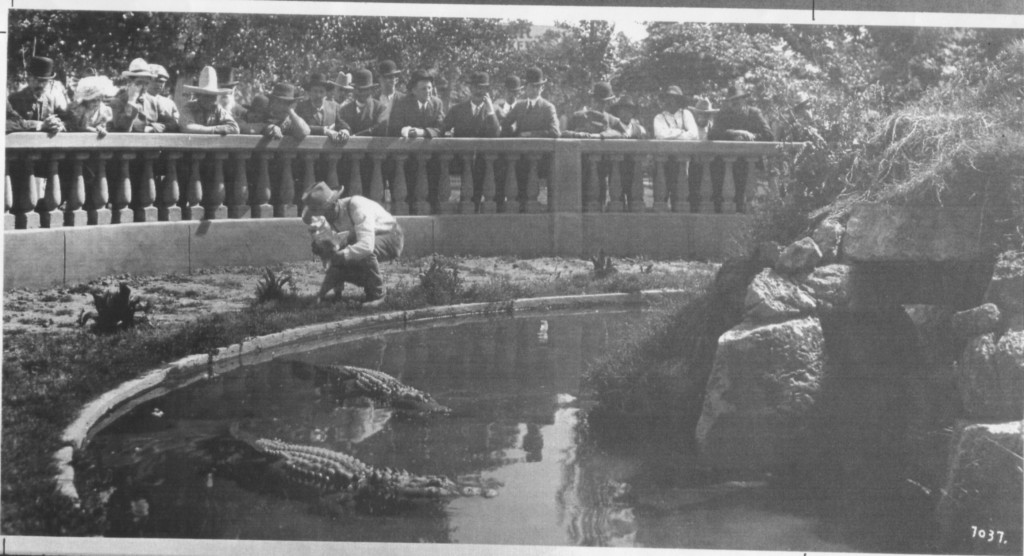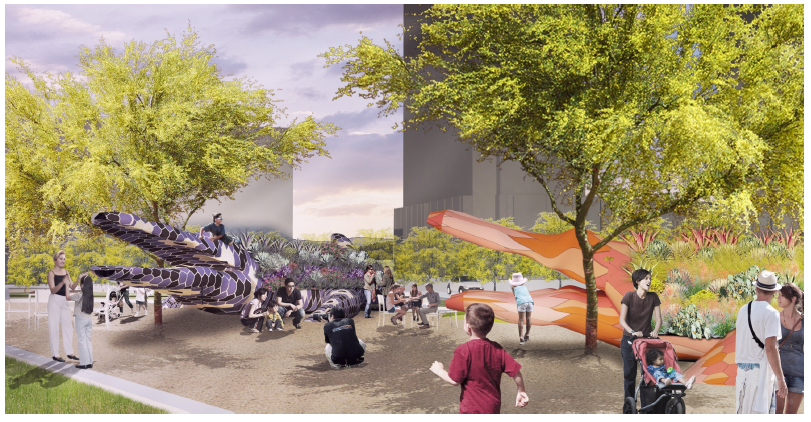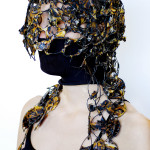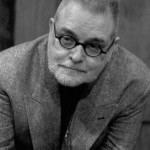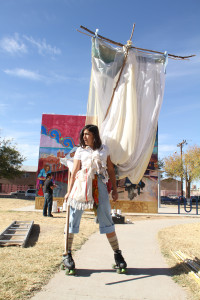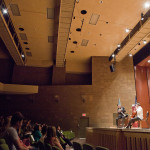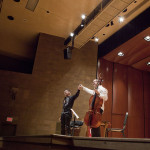Mole Festival
La Mujer Obrera brings Oaxaca to El Paso
By Victoria Molinar
Not everyone has the means to visit Oaxaca, Mexico, also known as the “Land of Seven Moles”—of course “mole” being the cherished sauce that in El Paso often consists of chocolate and is drizzled over chicken. That’s why the organization La Mujer Obrera is bringing a bit of Oaxaca to restaurant Café Mayapan during the Mole Festival on Saturday, July 20, from 6-10 p.m.
Only in this case, attendees won’t only be presented with one, but five different types of mole, including negro, rojo, coloradito, verde and the vegetarian mancha manteles.
“Mancha manteles, which literally translates to “table cloth stainer,” is a sort of spicy fruit sauce made with apple and banana slices,” said Blanca Castro, who helped put the “Mole Festival” together. “Instead of being served over meat, it is served over white rice with warm corn tortillas.”
Another unique item on the menu will be the tacos de chapulines—yes, cricket tacos.
“We’ve had people come in and ask about [the cricket tacos] and now we finally get to serve them,” said Athena Matyear, community outreach coordinator at Centro Mayapan, who also helped with the event. “Some people love them and other people see it as a challenge, daring each other to eat them, but most people are surprised to find that they taste good.”
While food will be a major cultural representation of Oaxaca, it won’t be the only one. Other highlights of the night will be the art and entertainment. Fair trade artistry from various parts of Mexico will be sold at Lum Metik, located right behind Café Mayapan. Oaxacan art will include traditional black clay pottery, clothing and alebrijes (those colorful folk art sculptures, usually of various animals and mythical creatures).
Oaxacan dance group, Huaxyacac (the original name given to what is now known as Oaxaca) will perform traditional dances of Guelaguetza, the state’s biggest festival held throughout July. The well-known local band Ceiba will also play pre-Hispanic Latin American music at the event.
Matyear said bout 4,000 people attended last year’s Mole Festival, which La Mujer Obrera started in 2005. The organization empowers women along the border by providing workshops and classes on citizenship, computer and Internet usage and earning a GED.
They also offer various cultural events to the public; prior to the mole festival, the group brough artisan women from Oaxaca to conduct workshops on their different types of traditional dances, music, artistry and cuisine. Putting a spotlight on various cultures throughout Mexico has been a main goal of La Mujer Obrera and Café Mayapan.
Last week, they launched their third season of their farmer’s market. Every Saturday from 8 a.m.-3 p.m. local farmers will sell their freshly picked produce. Breakfast will be served until 11 a.m. The restaurant is also open Monday through Friday from 11 a.m.-3 p.m.
For more information about Café Mayapan and La Mujer Obrera, call 915-217-1126 or visit MujerObrera.org and facebook.com/MujerObrera.
Melissa Castro
Q & A with Melissa Castro
By Monique Oxford
Melissa Castro uses the body as her canvas, painting and drawing on the human figure as she transforms her models into walking art pieces.
Monique: How did you become interested in art-specifically?
Melissa: I’ve always liked sketching, painting and working with my hands. When I realized I was good at makeup it just expanded my horizons beyond the typical beauty look.
Monique: You delve into more than one genre of body art, tell me about that.
Melissa: When it comes to the body/face I think I’m very versatile. I can make you look gorgeous for a wedding or horrifying for Halloween. My art is always evolving. One minute I can be really into my body art then next I’m focused on special effect wounds.
Monique: Any role models who influenced your work?
Melissa: Not when it comes to body art. I just go with what I’m feeling. As for my special effects makeup, Howard Berger, Robert Kurtzman, and Gregory Nicotero are such inspirations. They are amazing makeup artists. They are the masterminds behind movies like The Chronicles of Narnia and From Dusk Till Dawn. I would love to be on their level someday.
Monique: Did you take classes or intern with anyone to learn how to paint on the body?
Melissa: I’m completely self-taught. I do refer to YouTube videos, blogs and books occasionally to continue my education.
Monique: At what age did you start your art career?
Melissa: 18, it was the first Halloween after high school. I painted my face like a cat from the Broadway show, CATS. Everyone loved it and complimented my work so it inspired me to try more looks.
Monique: You were painting on a model at our launch party from Mitsu Overstreet’s installation piece at the El Paso International Airport, how did it feel when Mistu jumped in and began painting with you?
Melissa: I was beyond thrilled and a bit nervous!
Monique: Where do you draw your inspirations from?
Melissa: My body art pieces are freehand and though they are henna-inspired they definitely resemble my sketches. My special effects makeup is more on the fiction side I love to try and remake famous characters.
Monique: How time consuming are your designs?
Melissa: My designs are ridiculously consuming. I’m so meticulous when it comes to my work, particularly my special effects makeup. I give it my all so I expect only the best results.
Monique: Do you feel you are learning skills now that will elevate you? If so, what would those be?
Melissa: Definitely, the more I practice the more I learn. I’m always looking for new ways to express my creativity on my models, and means working with different materials and paints all the time.
Monique: Is there a particular project you want to work on?
Melissa: I would love to do makeup for a Tim Burton inspired photo shoot.
Monique: How are you further enhancing your career?
Melissa: I work with the skin all the time so I am furthering my education and getting my Esthetician license.
Monique: Where do you see yourself in ten years?
Melissa: I definitely want to continue working in the makeup industry, specifically in special effects. I want to make my name a trademark.
Monique: What is the biggest hurdle artists in El Paso face today?
Melissa: Speaking for myself I think there isn’t enough interest in the arts, especially in body art. I’m flooded with work for my glamour makeup but only get to showcase my special effects and body art sporadically. I do though, see a slow but growing interest in other art movements in El Paso. I can’t wait to see what the art scene will be like in a few years.
Monique: What is your biggest hurdle as an artist?
Melissa: I personally feel it’s pleasing my audience. My work and name get out there by word of mouth more than anything, so if I am not pleasing my audience I am not doing a good enough job.
Photographed by Omar Augustine Hernandez
San Jacinto Plaza
The downtown San Jacinto Plaza Park is on the verge of reconstruction. The Final plan to remodel the historic city block was presented to the public on June 20, by City officials at the El Paso Museum of History. The plan received mixed reviews from the public.
This is an historic event. The park is one of El Paso’s most important icons. It has survived the 154-year history of the city.
The initial name given to the park was Public Square. It has been called the Central Plaza, La Plaza, La Placita, The Alligator Park, Parque de Los Lagartos, and El Parque.
Anson Mills, who later became Mayor, surveyed and platted the first subdivision in El Paso, named the Plat of the Town of El Paso, in 1859, and his actions marked the birth of our city. On the plat, Anson Mills wrote on one of the city blocks “City Square.”
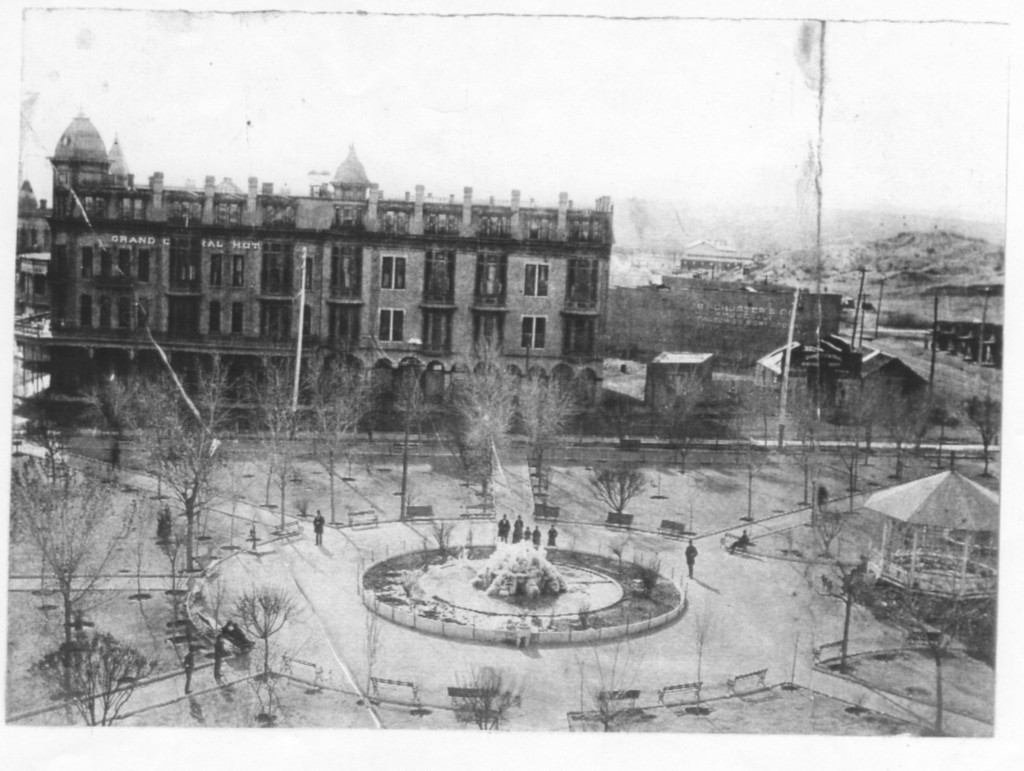 The downtown park changed with the times, but the original axial design has not been lost. It was a rather simple town square with a circle in the middle, wide sidewalks around the perimeter, angled sidewalks to the center, a water pond, and our alligators-not statutes. Real, swimming alligators!
The downtown park changed with the times, but the original axial design has not been lost. It was a rather simple town square with a circle in the middle, wide sidewalks around the perimeter, angled sidewalks to the center, a water pond, and our alligators-not statutes. Real, swimming alligators!
La Plaza de Los Lagartos grew and matured with the downtown buildings and the Placita saw the rise of the downtown buildings embracing the square, including the beautiful Trost Buildings.
U.S. soldiers who trained at Fort Bliss and Biggs Air Force Base in World War I and II, and the Korean Conflict enjoyed the alligators at the park. Millions of people from all walks of life from the El Paso region and from all over the world enjoyed the park. All roads, all streetcar lines, all buses, and all shoppers ended up at La Placita. It was where people met, enjoyed conversation, read the newspaper, or just sat at the bench to catch a bit of sun or live music from the park shell.
The alligators seldom moved. And they didn’t make any noise. That was O.K. It was the Plaza where a locomotive, a freight train, or a Pullman would run by on the north side of the square in its full glory; steam and the excitement of steel and steam noise, to make the place special.
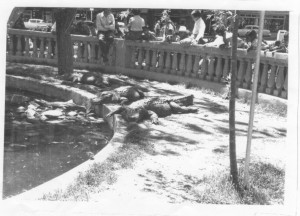 There are tons of stories of people who enjoyed the Plaza Park. Trolley and bus riders, pedestrians, downtown residents, tourists, shoppers, workers, etc. young and old, have a story to tell about the park. This is the downtown city block that has served more people per day than any other block. The Kress, the Popular, the White House, Newberry’s, Woolworth, Grants, and many other stores, generated people who used the park. The Coney Island Café, The Ellenay, the Plaza, the Wigwam, and other theater patrons used the Plaza as a destination point. Children from South El Paso came to the park because it was the only place that had grass.
There are tons of stories of people who enjoyed the Plaza Park. Trolley and bus riders, pedestrians, downtown residents, tourists, shoppers, workers, etc. young and old, have a story to tell about the park. This is the downtown city block that has served more people per day than any other block. The Kress, the Popular, the White House, Newberry’s, Woolworth, Grants, and many other stores, generated people who used the park. The Coney Island Café, The Ellenay, the Plaza, the Wigwam, and other theater patrons used the Plaza as a destination point. Children from South El Paso came to the park because it was the only place that had grass.
The alligators made an impression on people. It made it unique. It made you remember. It was El Paso.
According to the El Paso Herald, dated September 16, 1920, a prominent realtor and land developer, J. Fisher Satterthwaite was interviewed about the history of El Paso. He was the first City park commissioner of El Paso, appointed in 1882 and served for five years. Mr. Satterthwaite stated that he brought three alligators to El Paso from New Orleans in a cigar box. One of them later died. The other two lived to a ripe old age. Mr. Satterthwaite built the first pond for the original ‘gators. In time, the alligator population, through various actions, grew to as many as seven.
For over seven decades, the alligators, the circular pond with fish and turtles, and the balustrade fence were the trademark of El Paso. The alligators were the target of animal cruelty and in the mid 1960s the City moved them to the zoo.
In the 1970s, the City “improved“ the park which included the demolition of the gator cove, the pond and the balustrade circle.
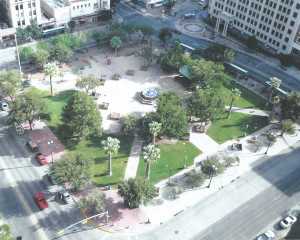 Shortly after, the City built a red brick pedestal with a water spraying system to display the alligator sculpture designed and built by renowned El Paso artist Luis Jimenez. The spray mist was devastating to the sculpture material. The City stopped the spray.
Shortly after, the City built a red brick pedestal with a water spraying system to display the alligator sculpture designed and built by renowned El Paso artist Luis Jimenez. The spray mist was devastating to the sculpture material. The City stopped the spray.
In March of 2011, the City of El Paso, in partnership with downtown businessmen and developers, began the process to hire a landscape-planning consulting firm to redesign the Plaza de Los Lagartos.
As the process progressed, it was apparent to me and to other citizens of the community that the plans being generated by the firm of SWA, while being professional in character, did not reflect the history of the park, nor were the plans reflective of the culture and social fabric of the community. Several concepts were presented. The concerns of the community were made known to City elected officials.
Specifically, the plans proposed obliterated the original 1870s diagonal axial design of the park. It removed the central circular motif the park, removed the Jimenez alligator sculpture, and infused a significant amount of desert landscaping. Other concepts presented were modern curvilinear in nature, totally unacceptable to El Paso’s downtown architectural and historical character.
On September 8, 2011, the City’s Economic Development, Planning and Tourism Legislative Review Committee voted to present the San Jacinto Plaza Park plan developed by the consultants to the Mayor and City Council within four weeks. Additionally, the Committee appointed myself to chair a citizens’ committee to review the consultant’s plan and report back to City Council within three weeks.
The San Jacinto Plaza Redesign Concept Plan Review Committee immediately began to work on the analysis of the concept plan and to develop recommendations to present to City Council.
On October 18, 2011, the Review Committee went before City Council and presented their findings and recommendations, including the presentation of a concept plan developed by the citizens’ group.
The Committee plan and recommendations emphasized the recovery of green lawn areas from previous “improvement” efforts that resulted in mass areas of concrete, pavers, bricks, and a great number of concrete planter boxes.
Among other recommendations, the Review Committee’s concept plan listed the following actions:
• Reinstate the historic 1880s diagonal design pattern for the park
• Keep the Jimenez alligator sculpture in the center of the park
• Build the balustrade circular structure around the alligator sculpture
• Inner circle of evergreen trees to protect the sculpture from sun rays
• Pop jet fountains/splash pads
• Keep the Christmas tree
• Ping pong tables
• Establish a streetcar café in the park using a real and historic streetcar that actually provided service between El Paso and Ciudad Juarez, Mexico.
After the presentation, the Mayor and Council voted to incorporate the trolley café into the final plan, keep the existing alligator sculpture in the center of the park, and reinstate the axial (diagonal) design pattern into the final officially approved park plan.
The consulting firm was instructed to incorporate the major items presented to the City by the Review Committee.
The new and approved final San Jacinto redevelopment plan incorporates most elements of the Committee.
 Lacking in the final approved plan is the recovery of the green lawn areas, and incorporates a more complex design configuration, a camouflage screen to protect the alligator sculpture instead of the large evergreen trees recommended.
Lacking in the final approved plan is the recovery of the green lawn areas, and incorporates a more complex design configuration, a camouflage screen to protect the alligator sculpture instead of the large evergreen trees recommended.
Construction of the park improvements are scheduled to start sometime in July of this year.
Once the plan is implemented and completed, the citizens of El Paso will have to accept the results. In general, the Committee’s recommendations were met.
The question is: will the general public be in agreement with the results?
Nestor A. Valencia
June 24, 2013
Members of the San Jacinto Review Committee:
Nestor A. Valencia – Chair
Katherine Brennand
Miguel Juarez
Mervin Moore, AIA
Xochitl P. Valencia
Joel Guzman
Peter Svarzbein
Photographs courtesy of Nestor Valencia
Bohuslav Rattay
By Rosemary Flores
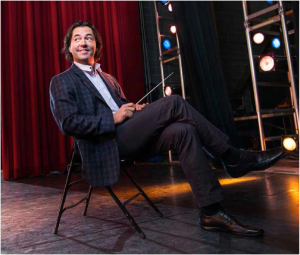
In my 21-year history with the El Paso Symphony Orchestra (EPSO), I’ve seen three music director searches, two of which lasted two years, and over 20 talented conductors came to El Paso from all over the world to audition to be the EPSO’s music director.
I have also seen three conductors prevail during the search process: Gürer Aykal in 1992; Sarah Ioannides in 2005; and Bohuslav Rattay, our new music director, who came on board in May 2013.
The search is an arduous process for conductors and EPSO board and staff. The process typically attracts more than 300 applicants from around the world. The candidates, usually six to eight of them are chosen, are each asked to conduct and help program two weekend concerts. They have only one week to rehearse and convince the 70 to 80 members of the orchestra to follow their musical interpretation of pieces they have performed many times under different conductors. These hopefuls must meet and impress over 30 board members, shake hands with major sponsors, and wow the audience.
During Rattay’s one-week stay in El Paso in October 2012, the 40-year-old Czech Republic native managed to charm and impress members of the orchestra, board members, staff and audience. On May 5, 2013, the official announcement was made. Bohuslav Rattay was announced EPSO’s new conductor and music director.
Each conductor brings his or her own musical background, training, and ideas. What they lack sometimes is a strong knowledge of and familiarity with the city in which they will be working, not to mention the people they will be leading. Immediately, everyone had the feeling that Bohuslav would have no problem immersing him in the culture of our great city.
Bohuslav played bassoon from the age of 10, studied at the Conservatory in Prague for six years, played in an orchestra for 15 years, and is a graduate student of Rice University in Houston and the Peabody Institute of Music in Baltimore. And he’s a pretty good baritone singer!
He is very friendly and approachable and has an easy spirit about him. He has an open attitude and love for life, music and people. He enjoys hiking, riding his motorcycle and cooking. Though he also leads orchestras in Lake Charles, La., and Midland, Mich., he has decided to make El Paso his home and is currently hunting for a house to call his own.
This summer, Bohuslav will be in El Paso in to conduct his first concert as the new music director. Called “Pop Goes the Fort,” it’s a program of patriotic and pops music planned for July 4th at Biggs Park. Nashville’s sibling trio Shuggah Pies also will perform. This marks the third consecutive year that EPSO has teamed up with the USO and Fort Bliss’ office of Family, Morale, Welfare and Recreation to entertain military personnel and the general public on post.
Bohuslav, or “Bo” as most people call him, is also hard at work on creating what promises to be an exciting first season as the new leader of Texas’ longest continuously operating symphony orchestra. The baton has been passed. Bohuslav Rattay is ready to take it and lead EPSO and El Paso’s growing arts community confidently into a promising future.
From the Top
By Lorain Watters
June 1, the El Paso Plaza Theatre hosted NPR’s “From the Top” for the second time since 2008, as young musicians filled the theater with pieces from Wieniawski, von Weber and Lutoslawski.
Musicians from age 11 to 19 wowed audiences from start to finish with intricate pieces, along with a few jokes from host Christopher O’Reiley. Among the talented performers was Wesley Yu, a recent graduate from Coronado High School, who got on the show after submitting his tapes, he was chosen as one of the five performers.
“I heard about this show when I was a little kid so I just thought ‘why not’ and I did it,” Yu said.
With an hour long performance from piano, clarinet, organ, harp and Yu on violin, El Pasoans were witness to an evening filled with classical pieces played by young artists.
Blurring Borders
By Riddel Nigma
Riddel: What themes do you explore in your work? Do you think it’s hard to communicate messages through jewelry?
Haydee: I’ve dealt with subjects as varied as global warming, personal conflicts, to simple mundane life predicaments. Jewelry is such a broad range of things, from an engagement ring to a piece such like “Self Contained.” It’s quiet tricky to portray a message in any medium, jewelry isn’t any different.
R: How did living in the border affect the way you look at art?
H: We have all been forced to alternate between cultures and customs. It’s involuntary to face the problems of both countries equally. While my works for the body do not focus solely on the United State’s economic crisis, or Mexico’s fraud of a presidential election, problems from both sides of the border influence my creative process in a conscious and subconscious manner.
R: Is this what led you to create your award winning piece “Ni Una Mas”?
H: “Ni Una Mas” relates to “the dead women of Juarez.” Growing up the newspaper would depict explicit pictures of these young newcomer maquiladora workers that would end up in vacant lots, lying amidst tin cans, diapers, and car tires. The neckpiece of tightly woven rubber was created to emulate the feeling of asphyxiation with the debris in which these women were camouflaged. My intention is to honor and remember these unfortunate victims.
R: Not only do you do art for the body but have actually transformed your own body into a piece. Do you feel this is a natural progression of the medium?
H: I don’t know if I would call it a natural progression, but jewelry is constantly making me think about the body and its relationship to it. Leaving the jewelry out turned out to be an interesting approach.
R: With your performance piece “I Just Want to be Loved” you fully exposed yourself both physically and emotionally. How did it make you feel then? How do you feel about it now?
H: In a word, “raw.” I wanted to create a piece that was beautifully grotesque. I dieted, dressed up, used proper language, wrote, and recorded journals for the duration of the performance. It was important to make it personal yet still be accessible to my audience. I took four pictures of myself, naked, every day for a month. This image of a nude body became exactly that, just an image. After a while I didn’t feel I was exposing myself, I had become the medium. I believe it my most successful piece to date. When people listened to my recordings they would say, “This isn’t right, I feel like I shouldn’t be listening to this.” It always makes me smile when I think about this piece; it has a deep connection to myself.
R: One of your performances involved a self-injury of sorts; do you feel such an extreme necessary to effectively convey the message?
H: The pain inflicted upon myself in this particular piece was vital. “Gita” is a sacred song characterized by a belief in reincarnation and liberation from earthly evils. Through the ritual of piercing, I reclaimed my body from an indecent assault. I healed my wounds.
R: I understand that you’ve traveled since you got your BFA from UTEP. Where have you gone? How have your travels helped you grow as a person and as an artist?
H: I wanted to continue on to graduate school, but didn’t feel quite ready yet. So immediately after graduation I went to Bodh Gaya, India for 5 months where I lived with Burmese monks as a volunteer. I taught them English and Spanish, and in return they enlightened me about Theravada Buddhism, their culture, their way of life, and more importantly myself. I’ve become a more patient person and have learned that positive thinking will bring positive results. I have absolutely no idea how this will affect me artistically but I’m sure it will manifest itself just like my semester abroad in Paris has.
R: Do you feel like you’re ready to pursue your graduate degree now? Have you been accepted anywhere?
H: Yes I do! I applied to about four different programs in five different school each, performance art, fiber, even fashion, and of course metalsmithing. I am lucky enough to have been accepted into the five schools I applied, but chose the Royal College of Art in London above the rest.
R: What an amazing opportunity to have been accepted into such a prestigious school! Are you ready to make the transition?
H: Of course I’m ready to make the move, but there are quite a few things that need to happen prior to. (From my visa, to finding accommodations, health insurance, and loads and loads of loans) I’m in the process of selling my car and my studio and am still working full time as a waitress. There’s still a tremendous gap of money that needs to be filled. As a result I’ve started a fundraiser. I realize that loans are inevitable but I’m trying to soften the blow if possible.
R: It’s been a pleasure talking with you. Where might someone donate to your campaign? Is there some place where we can see your work?
H: Of course! “Ni Una Mas” and “Nature is Worth More Than a Human Being … It’s Worth More Than 1,000,000 of Them” are part of the permanent collection of the Stanlee and Gerald Rubin Center for the Visual arts. I also have a website: http://cargocollective.com/haydeealonso
This is the website for my campaign is: https://fundrazr.com/campaigns/3V1N3
Photographs courtesy of Haydee Alonso
Freud’s Last Session
By Kathryn Smith-McGlynn, MFA MPA
Got religion? Judaism, Christianity, Muslim, Hinduism, Buddhism…is there really something out there greater than us mere human beings and with so many pathways, do they all lead to the same thing? Religion or a lack thereof, remains a hot topic among the young and old. From disillusioned baby boomers leaving the Church in droves to the millennium generation creating their own brand of ‘pub theology’ (bible study and a pint), it seems folks today are stepping back and taking stock of what religion really means to them and how it fits into their lives(1). Emergents, Atheists, Agnostics, even entertainers are getting into the mix. Case in point, after a long hiatus, Hip Hop Artist ‘Speech’ of the grammy award winning group Arrested Development is stepping back into the spotlight, only now he is out right ministering and not just through music. Speech is creator of The Mixtape, a religious endeavor that combines entertainment networking with religion. Mixtape’s tag line is “Edification Through Holy Scripture” — that isn’t a far cry from the group’s hit song “Tennessee” which asks the Lord to:
“Take me to another place
Take me to another land
Make me forget all that hurts me
Let me understand your plan”
On the surface it may look like a new trend, but of course the debate over religion really isn’t a novel idea. The fact is, Man [and Woman], has disagreed over the existence of God for ages and those that do believe have fought over who to believe in, how to believe and where to believe [worship] and like Speech, artists and cultural icons have at times been at the center of the debate.
A dramatization of such a debate between two historical icons drives the action in Frontera Repertory Theatre Company’s upcoming production Freud’s Last Session. In what are the last weeks of Freud’s life, between bomb scares and high tea, Sigmund Freud and C.S. Lewis butt heads as they engage in heated discourse on religion, sex, and a myriad of topics, on the day England enters World War II.
C.S. Lewis, perhaps best known for penning The Chronicles of Narnia, was a Christian Apologist in the latter part of his life. He started out however, as an atheist. An atheist who used the science of Sigmund Freud as the basis of his rationalization (which he later rejected when he turned to Christianity). Freud on the other hand was steady in espousing his psychoanalytic theories grounded in science on everything from sex to God. So why did Lewis change his mind about believing and was Freud really as staunch an atheist as was thought? Freud’s Last Session ponders these questions and more and is sure to spur dialogue on one of the most controversial subjects in history.
(1 According to research conducted by The Pew Forum on Religion and Public Life, “The number of Americans who do not identify with any religion continues to grow at a rapid pace. One-fifth of the U.S. public – and a third of adults under 30 – are religiously unaffiliated today, the highest percentages ever in Pew Research Center polling.”)
Freud’s Last Session stars Jac Alder who re-creates the title role of “Sigmund Freud,” which he performed last fall in Dallas to great acclaim. Appearing opposite Mr. Alder is Tony nominated and Obie award winner Stephen Bogardus as “C.S. Lewis.” Freud’s Last Session is presented May 4 & 5 at the Philanthropy Theatre in downtown El Paso, as part of Frontera Repertory Theatre Company’s concert playreading series. Tickets may be purchased at the Plaza Theatre Box Office, Ticketmaster.com, and all Ticketmaster outlets, or call (800)745-3000. For more information visit www.fronterarep.org.
Kathryn Smith-McGlynn, MFA, MPA, is an El Paso-based actor, scholar and writer. She is a Visiting Assistant Professor at the University of Texas at El Paso and Co-Founding Artistic Director/Executive Producer of Frontera Repertory Theatre Company.
Photographs courtesy of Frontera Rep Theater
Xochitl
The Art Avenue: How did growing up on the border influence your work?
Xochitl: I don’t know if I knew how growing up on the border affected me while I was growing up. It took me leaving, going as far away as I could possibly go, to understand how much of who I am is in me because of where I grew up. It took me leaving everything I thought I knew behind, to really understand it. My understanding of people, the way we reacte, the way we treat each other, the way “smaller” people relate to “bigger” people… I think in a really profound way, being from El Paso, helped me understand social justice on a really broad level, when I lived in Bhutan. It allowed me to understand HOW to identify what was wrong, what was unfair… and it was almost instinctual to know HOW to fix things. I could speak hybird languages-not because I’m from a city where “spanglish” is everywhere, but because I’m from a city where two worlds truly do coexist on every level.
I think we’re so fortunate to live in El Paso… so many things become innate. Our methods of communication are different, the way we understand demographics is different, the way we relate to the world is different. We’re not only a border between two nations, we’re at the epicenter of cultural, economic, and social exchange. It blows my mind all the time… and my work has definitely begun to focus on universal happenings that manifest really uniquely on our border…and at junctions of people, places, environments…
The desert has also taught me a thing or two… It is as unique and enchanting as anything I saw in the Himalayas.
The Art Avenue: What responsibility does an artist have in representing their culture or community?
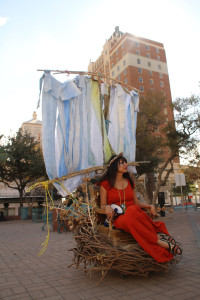
Xochitl: I don’t know that I would necessarily say we have a responsibility to “represent” our culture– I think artists are the drivers, producers and custodians of culture. I think it’s important for artists, especially in city’s like ours that are forever running the risk of falling behind or being marginalized, to truly take a look around at what is really happening and produce work that affects what is happening. I think our people represent our culture… I would say I only want to be a reflection of it… reflections are much less decisive and concrete. Artists are the ultimate form of mighty, and our role in society is unmatched, which always makes me acknowledge how careful we have to be when we produce work that “represents” anything!
The Art Avenue: What artists are you influenced by or do you admire?
Xochitl: This list is always changing lately… as it should for any artist. I guess my favorite well-known artists to study in the last couple of years have been Ai Weiwei and Cai Guo-Quiang. I think work coming out of China has been really truly revolutionary and totally exciting.
I love Sway, for her delivery and relentless grace in producing work that tends to give a really fantastic metaphorical bird to institutions.
Tania Candiana, an amazing artist I met while I was at UTEP, has also been hugely influential for me. I don’t know if she knows it, but she helped engrain so many of my artistic principles into practice. I’m always exploring and finding new cravings…but these four are probably my biggest heroes.
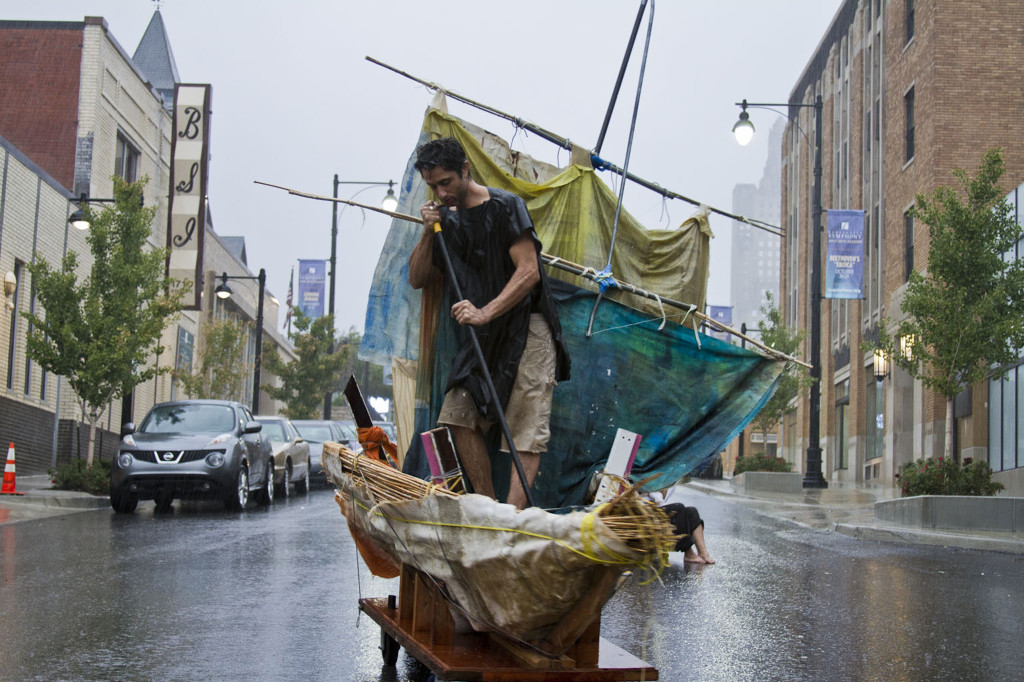
Citizens of the World
2+1 Masters
By Aracely Lazcano
When world-renowed Mexican flutist Horacio Franco and Israeli native cellist Asaf Kolerstein performed at the Fox Fine Arts Auditorium in the University of Texas at El Paso they had a mission in mind, to show their audience why their musical combination is a universal language. The recital, 2 + 1 Masters was presented by the Consulate General of Mexico and UTEP.
“We want them to know our cultures share more than a region or economy; we want to make them link their emotions with their senses. We play music from the world because we are citizens of the world,” said flutist Horacio Franco.
For over an hour, both musicians indulged the spectators with a repertoire ranging from the classical Baroque composers Vivaldi and Bach all the way to the 60’s and 70’s with pieces written by John Lennon and interpreted by The Beatles.
Perhaps the songs The Fool on the Hill, Penny Lane, Martha My Dear and Eleanor Rigby filled the audience with an ingenious climax, the remarkably executed Sonata in a minor from Antonio Vivaldi turn out to be the surprise of the night. Originally the piece was written by the prolific composer for violin and cello, but was adapted by the Mexican flutist for his instrument.
“He is a fantastic improviser, not only by putting the extra notes, but also the expression and character of the melodies,” said cellist Asaf Kolerstein about his partner on stage.
Although he never spoke during their performance, in an exclusive interview for The Art Avenue Magazine, he added that “performing together is a wonderful opportunity to be musically connected and which spills over the audience and makes it a special moment for everybody in the room,” he concluded.
Horacio Franco owns a vast repertoire that ranges from medieval, Renaissance and Barroque to contemporary works. He has broken the stereotype of the traditional classical musician and has been acclaimed by international critics like one of the worthiest representatives of his instrument at a world-wide level.
“It was in high school in Mexico City when I began to play the flute. I fell in love with it and it chose me, now it is taking me around the world.”
Franco studied in the National Conservatoire in Mexico and finished “Cum Laude” at the Sweelinck Conservatorium in Amsterdam, Holland. He has had outstanding performances as a soloist of major orchestras such as the Academy of Saint Martin in the Fields, City of Birmingham, American Composers, Berliner Symphoniker, Tokyo Solisten, among many others.
Even though cellist Asaf Kolerstein was born in Tel Aviv, he now lives and works in Mexico City where he is considered the most important cellist in recent history. He studied mathematics at Berkley University, then obtained his Masters in Music at the University of Boston and got a diploma in violoncello from the Musical School “Longy” in Cambridge, Massachusetts.
Like Franco, Kolerstein has participated in many orchestras and chamber music groups around the world and shares his passion for music with his 150 years old French cello which he describes as a “70 year old woman with great character who has been smoking and drinking whiskey for 50 years.”
Photographed by Laura Bustillos


